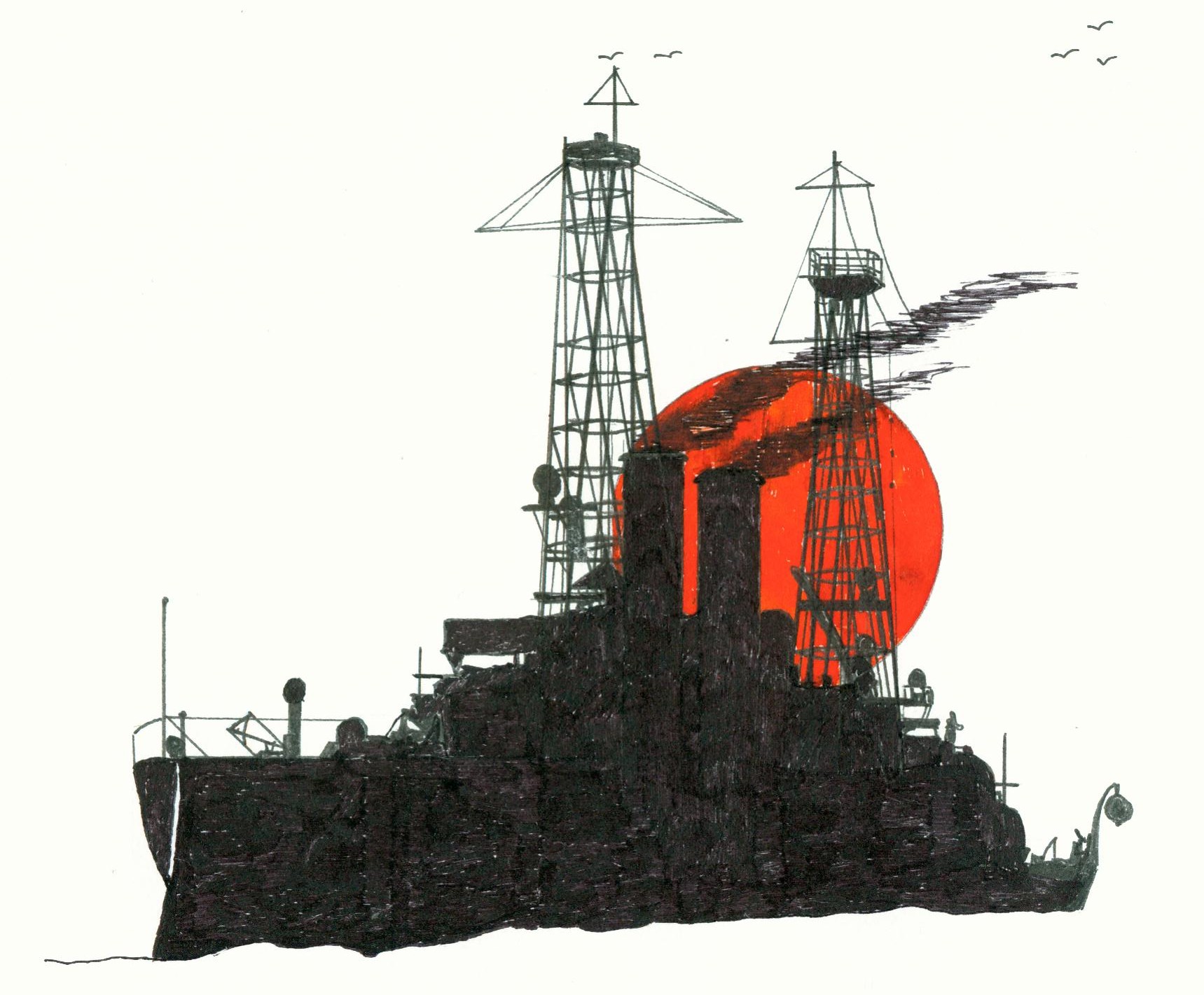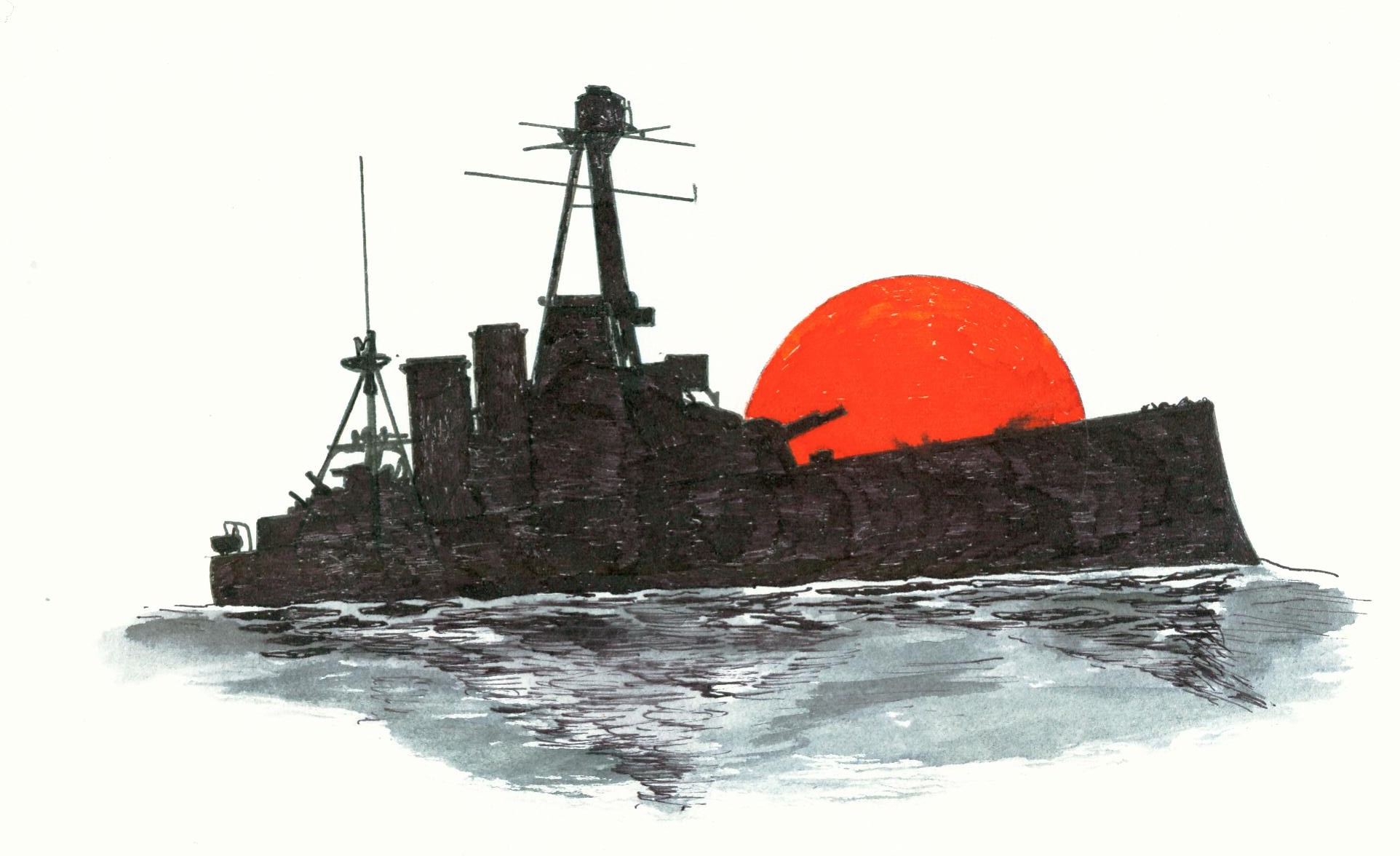In the First World War Greece was like the Netherlands in advance no part of one of the two alliances like the Triple Entente consisting of Russia-France-United Kingdom and her counterpart the Triple Alliance consisting of Germany-Austria-Hungary –Italy. Greece was piece by piece drawn into the war and finally more or less forced to choose for the Triple Entente. Staring with a German-Bulgarian invasion in May 1916 and in September the same year of the handing over of Kavalla to Bulgaria resulted in a provisional government at Thessalonica with as president Eleftherios Venizelos while Greece was a constitutional monarchy with as king Constantine. Constantine was finally forced 14 June of the next year to hand over his thrown to his second son Alexander. The next result was Greece declaring officially war on the Central Powers. In 1916 was a large part of the Greek fleet seized by the Allies and the smaller vessels taken into French service mainly used for anti submarine patrolling
The New Zealand newspaper Evening Post of 13 October 1911 supplied details dealing with the Greek naval strength. According to the article published in this newspaper the Greek navy consisted that moment of 33 ships, namely five battle ships (1), the armoured cruiser Giorgios Averoff (2), the unarmoured cruiser Helli, 14 destroyers, two submarines and some old gunboats and non combatant vessels. Intended to hand over to the Provisional Government were 14 destroyers, 6 gunboats, 4 gunboats and two submarines.
Dutch (local) newspapers were published several items dealing with this topic which I placed in next chronological sequence.
The Vlissingse Courant dated Thursday 12 October 1916 reported yesterday 13.00 o’clock that the commanding officer of the French squadron handed over to the Greek government an ultimatum demanded the surrender of the complete Greek fleet excluded the Averoff, Lemnos and the Kilkisch to secure the safety of the Allied fleet. The Greek minister of navy stated that the demands were accepted and that the fleet was handed over. The Ierseke en Thoolsche Courant dated 14 October mentioned the surrender of the complete fleet accept for the three ships which were to be disarmed.
The newspaper Het volk: dagblad voor de arbeiderspartij daily edition dated 12 October 1916 published an item dated London, 11 October. The newspaper Daily Chronicle received tidings from Athens that the transfer of the Greek fleet started. The largest ships were to be disarmed in the Gulf of Keratsini while the smaller vessels were made available to the temporarily Greek government. French authorities take that afternoon possession of all warships, some crews went all ready on shore, and others were preparing to do so. French sailors take over the smaller vessels.
The Middelburgsche Courant dated 14 October 1916 published an account of the surrender written by a correspondent of Reuter who was at that time on board of the Lemnos. Thirteen French and two British tugs, twelve French and British trawlers, a British destroyer and an Italian launch needed 2,5 hours to tow the ships from the arsenal towards Keratsini. The ships involved were the Kanaris flagship of admiral Ipitis, the cruiser Helle, the submarine Delphin, the torpedo boats Leon, Niki, Naphkratoesa, Nea Genea, Aetos, Thyella, Dexa, Keravonis, Jerax, Sfendoni, Aspis, Velos, Arethusa, Egri and Lonchi and the steam launch Coriolanus, the latter serving as a ferry between Pireaus and the Arsenal. As soon as the Greek government decided around 04.00 o’clock to hand over her fleet was a telegram sent to the arsenal and were all men wake up and ordered to get their belongings. At 10.30 o’clock when they were finished was on each ship a parade and the crews informed by their commanding officers that the navy was forced by the Entente to leave the ships. The Greek king permitted all men to stay on board which want to serve with the Allied forces. However every man went from board, the officers taken the kings’ photo and the flag of the ship with them. The sailors were transported to Scaramanga at the mainland opposite of the Arsenal at Salamis. There they waited for further transport to Athens. Admiral went on board of the Lemnos and locked himself up while his ships were towed away.
The Rotterdamsch Nieuwsblad daily edition dated 17 October 1916 used for her news item Italian newspapers which reported that one third of the large Greeks cruisers were taken into Allied service. The smaller vessels were not to be disarmed but their Greek crews were removed. The two submarines and 24 torpedo boats were immediately used for pursuing submarines belonging to the Central Powers. The newspaper Tribunal also reported that the Entente seized the fleet fearing she was going to the Dardanelles to join the Turkish navy.
The Vlissingse Courant dated 18 October 1916 reported that sailors of the Allied fleet take over the Greek ships [Georgios] Averoff, Kilkis and Lemnos while sending the Greek crews toward Athens.
The Nieuwe Rotterdamsche Courant morning edition dated 10 November 1916. London, 9 November. The French occupied the arsenal where all the ammunition for the Greek fleet was stored. The French admiral also ordered to hand over the capstones of the guns of the smaller vessels which were removed by the Greek crews when they left their ships although being ordered otherwise.
The Breskensche Courant dated 12 November 1916 reported that Wednesday the French flag was to be hoisted on the smaller Greek vessels.
The Rotterdamsch Nieuwsblad daily edition 8 November 1916. According tot tidings was the French flag hoisted on board of the Greek flotilla of small ships at Keratsini.
Notes
1. See the note “The Greek battleships Kilkis and Lemnos” published on this web log.
2. See the note “Greek armoured cruiser Georgios Averof (1910-still existing as museum ship at Faliron and the note “The Greek navy in 1912 according to the Dutch newspaper Middelburgsche Courant”, published on this web log.
The Greek Kilkis
The Greek Georgios Averoff
Dutch (local) newspapers were published several items dealing with this topic which I placed in next chronological sequence.
The Vlissingse Courant dated Thursday 12 October 1916 reported yesterday 13.00 o’clock that the commanding officer of the French squadron handed over to the Greek government an ultimatum demanded the surrender of the complete Greek fleet excluded the Averoff, Lemnos and the Kilkisch to secure the safety of the Allied fleet. The Greek minister of navy stated that the demands were accepted and that the fleet was handed over. The Ierseke en Thoolsche Courant dated 14 October mentioned the surrender of the complete fleet accept for the three ships which were to be disarmed.
The newspaper Het volk: dagblad voor de arbeiderspartij daily edition dated 12 October 1916 published an item dated London, 11 October. The newspaper Daily Chronicle received tidings from Athens that the transfer of the Greek fleet started. The largest ships were to be disarmed in the Gulf of Keratsini while the smaller vessels were made available to the temporarily Greek government. French authorities take that afternoon possession of all warships, some crews went all ready on shore, and others were preparing to do so. French sailors take over the smaller vessels.
The Middelburgsche Courant dated 14 October 1916 published an account of the surrender written by a correspondent of Reuter who was at that time on board of the Lemnos. Thirteen French and two British tugs, twelve French and British trawlers, a British destroyer and an Italian launch needed 2,5 hours to tow the ships from the arsenal towards Keratsini. The ships involved were the Kanaris flagship of admiral Ipitis, the cruiser Helle, the submarine Delphin, the torpedo boats Leon, Niki, Naphkratoesa, Nea Genea, Aetos, Thyella, Dexa, Keravonis, Jerax, Sfendoni, Aspis, Velos, Arethusa, Egri and Lonchi and the steam launch Coriolanus, the latter serving as a ferry between Pireaus and the Arsenal. As soon as the Greek government decided around 04.00 o’clock to hand over her fleet was a telegram sent to the arsenal and were all men wake up and ordered to get their belongings. At 10.30 o’clock when they were finished was on each ship a parade and the crews informed by their commanding officers that the navy was forced by the Entente to leave the ships. The Greek king permitted all men to stay on board which want to serve with the Allied forces. However every man went from board, the officers taken the kings’ photo and the flag of the ship with them. The sailors were transported to Scaramanga at the mainland opposite of the Arsenal at Salamis. There they waited for further transport to Athens. Admiral went on board of the Lemnos and locked himself up while his ships were towed away.
The Rotterdamsch Nieuwsblad daily edition dated 17 October 1916 used for her news item Italian newspapers which reported that one third of the large Greeks cruisers were taken into Allied service. The smaller vessels were not to be disarmed but their Greek crews were removed. The two submarines and 24 torpedo boats were immediately used for pursuing submarines belonging to the Central Powers. The newspaper Tribunal also reported that the Entente seized the fleet fearing she was going to the Dardanelles to join the Turkish navy.
The Vlissingse Courant dated 18 October 1916 reported that sailors of the Allied fleet take over the Greek ships [Georgios] Averoff, Kilkis and Lemnos while sending the Greek crews toward Athens.
The Nieuwe Rotterdamsche Courant morning edition dated 10 November 1916. London, 9 November. The French occupied the arsenal where all the ammunition for the Greek fleet was stored. The French admiral also ordered to hand over the capstones of the guns of the smaller vessels which were removed by the Greek crews when they left their ships although being ordered otherwise.
The Breskensche Courant dated 12 November 1916 reported that Wednesday the French flag was to be hoisted on the smaller Greek vessels.
The Rotterdamsch Nieuwsblad daily edition 8 November 1916. According tot tidings was the French flag hoisted on board of the Greek flotilla of small ships at Keratsini.
Notes
1. See the note “The Greek battleships Kilkis and Lemnos” published on this web log.
2. See the note “Greek armoured cruiser Georgios Averof (1910-still existing as museum ship at Faliron and the note “The Greek navy in 1912 according to the Dutch newspaper Middelburgsche Courant”, published on this web log.


